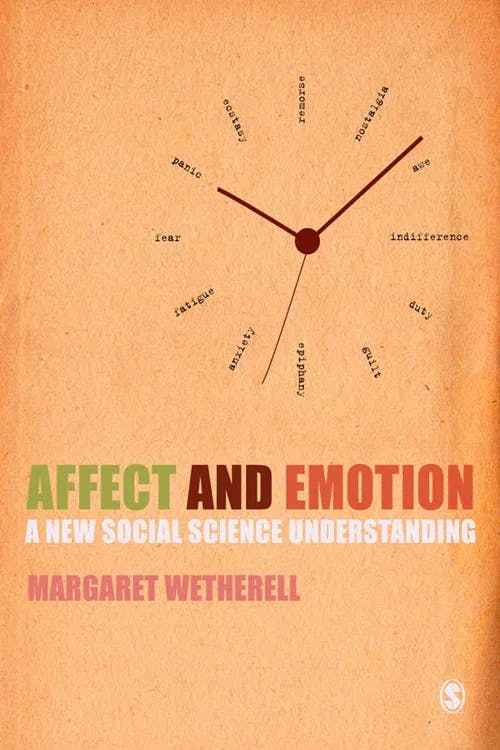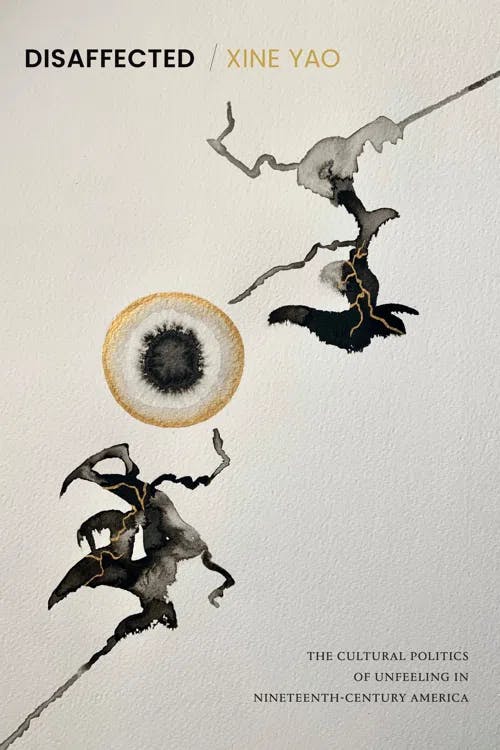What is Affect Theory?
PhD, Media Arts and English Literature (Royal Holloway, University of London)
Date Published: 21.06.2023,
Last Updated: 10.08.2023
Share this article
Defining affect theory
Affect theory can be broadly understood as the critical study of feelings. Whether it is the exploration of happiness, excitement, shame, or surprise, or theorizing how these feelings might move around and jump between bodies or objects; affect theory can be used to consider ontological and political questions about how emotions operate in the world. Following the “affective turn” that took place in the mid-1990s, an increased scholarly interest in the implications of such questions has taken place, forming two different critical trajectories: one follows the work of Gilles Deleuze, Baruch Spinoza and Henri Bergson; and the other is inspired by the work of Eve Kosofsky Sedgwick and Silvan Tomkins.
However — much like the ineffable feelings or forces that affect theory attends to — it evades straightforward definition. It is not a settled or singular method, defies stable explanation and reconfigures disciplinary boundaries. Indeed, as Mathew Arthur (2021) observes, it can rethink and “rewire” the connections between different disciplines, where the idea of “affect” operates both across and within the intersections between literary criticism, cultural and political theory; feminist, critical race, queer, trans, and disability studies; neurohumanities, biopolitics, anthropology, geography, and philosophy.
What does "affect" mean?
Used to approach a number of encounters from various perspectives, the term "affect" holds a multitude of meanings. It is sometimes used to refer to feelings, emotions, moods, sensations, forces, potentials, relations, vibes, atmospheres, encounters, intensities, or states. Sometimes, as Margaret Wetherell (2012) notes in Affect and Emotion: A New Social Science Understanding, affect,
refers just to physical disturbance and bodily activity (blushes, sobs, snarls, guffaws, levels of arousal and associated patterns on neural activity).
Margaret Wetherell
refers just to physical disturbance and bodily activity (blushes, sobs, snarls, guffaws, levels of arousal and associated patterns on neural activity).
Many strands of affect theory emphasize the unconscious or — as Wendy J. Truran writes — “other-than-conscious forces that make subjects and worlds, and the entangled materiality of both” (2022). Affect theory challenges a humanistic understanding of emotion as a trope of expression that is somehow dependent on the existence of the self or as “something lifted from a depth to a surface”, as Rei Tereda writes in Feeling in Theory (2009).
Instead, Melissa Gregg and Gregory Seigworth suggest that
affect is found in those intensities that pass body to body (human, nonhuman, part-body and otherwise), in those resonances that circulate about, between, and sometimes stick to bodies and worlds, and in the very passages or variations between these intensities and resonances themselves. (“An Inventory of Shimmers”, in The Affect Theory Reader, 2010)
Affects can be thought of as unmoored from the subject, autonomously flowing in and out of what Gregg and Seigworth describe as “bloom-spaces” (2010), or what Kathleen Stewart calls “an animate circuit that conducts force and maps connections, routes, and disjunctures" in Ordinary Affects (2007). Within this “contact zone”, Stewart continues, affect is the “Some-thing [that] throws itself together in a moment as an event and a sensation; a something both animated and uninhabitable” (2007). The epistemological drift that this "some-thing" possesses can be productive, providing varied and multiple lines of inquiry.
Critics have delineated two approaches to affect theory: as entangled but divergent “trajectories” (Truran, 2022), “versions” (Schaefer, 2019), “vectors” (Gregg and Seigworth, 2010), “incarnations” (Figlerowicz, 2012), strains or streams: one influenced by the works of Deleuze, Spinoza and Bergson; and the other stemming from work by Tomkins and Sedgwick.
“The Affective Turn”
The phrase “the Affective Turn” has been attributed to Patricia Clough, where she used to describe the growing interest in affect theory in the mid-1990s (2007). She summarizes the turn as the “increasing significance of affect as a focus of analysis across a number of disciplinary and interdisciplinary discourses occurring at a time when critical theory is facing the analytic challenges of ongoing war, trauma, torture, massacre, and counter-terrorism”. However, Cvetkovich observes in Depression: A Public Feeling (2012) that although “the affective turn” implies that this is a recent or new phenomenon, “this work has been going on for quite some time” in feminist scholarship, postcolonial studies, queer theory, and anti-racist work.
What does affect theory do?
Schaefer traces affect theory’s complex genealogy in The Evolution of Affect Theory, stating that, as an approach and a method, it “asks what bodies do — what they want, where they go, what they think, how they decide — and especially how bodies are impelled by forces other than language and reason” (2019). By asking these questions, affect theory can attend to and critique political and social structures. As Brian Massumi writes in Politics of Affect, affect theory can be conceived of not as:
a discipline of study of which the politics of affect would be a subdiscipline. It is a dimension of life — including writing, including of reading — which directly carries a political valence. [...] To affect and to be affected is to be open to the world, to be active in it and to be patient for its return activity. (2015)
Brian Massumi
a discipline of study of which the politics of affect would be a subdiscipline. It is a dimension of life — including writing, including of reading — which directly carries a political valence. [...] To affect and to be affected is to be open to the world, to be active in it and to be patient for its return activity. (2015)
Giles Deleuze & affect theory
For the French philosopher Deleuze, affect is entirely separate from the notion of conscious emotion. Within the poststructuralist and philosophical works inspired by Deleuzian thought, affect’s exteriority and pre-personal quality is integral. Deleuze’s configuration of affect was influenced by Spinoza’s theological discussion in Ethics (1677 [2020]), where Donovan O. Schaefer explains that Spinoza’s ideas of affect are rooted in a monist conception of God — which he defines as a “substance consisting of infinite attributes each of which expresses an infinite and eternal essence” (Spinoza, 2020) — where the “infinite attributes” are “affectations”, and therefore prior in nature (Schaefer, 2019).
Deleuze also engaged critically with Henri Bergson’s ideas of creative emotions, where he writes in Bergsonism (1991) that:
emotion is always connected to a representation on which it is supposed to depend. We are then placed in a composite of emotion and of representation, without noticing that it is potential, the nature of emotion as pure element. The latter in fact precedes all representation, itself generating new ideas. It does not have, strictly speaking, an object, but merely an essence that spreads itself over various objects, animals, plants and the whole of nature.
Part of the Deleuzian project also involved a turning away or reconfiguration of the Cartesian split between body and mind, by focusing on the incorporeality of affect.
Thus, influenced by Spinoza and Bergson’s thinking, Deleuze locates affect in — as Gregg and Seigworth explain — “the midst of things and relations (in immanence) and, then, in the complex assemblages that come to compose bodies and worlds simultaneously” (2010), in a state of becoming.
Summarizing this approach to affect, Truran highlights the emphasis on change, as “inherent to affect” as it “carries potentiality in its emergent relation” (2022), always unfolding and “becom[ing]with the world” (Deleuze and Guattari, 1994).
Silvan Tomkins and Eve Kosofsky Sedgwick
Truran describes the second trajectory within affect theory as a “Feminist/Queer/Cultural” camp, which “seeks to make change more immediate and tangible through scholarship and activism” (2022). Here, unlike the Deleuzian formation, the terms affect and emotion are both harnessed. On the use of "affect" and "emotion", Sianne Ngai writes in Ugly Feelings that “affects are less formed and structured than emotions, but not lacking form of structure altogether; less 'sociolinguistically fixed,' but by no means code-free or meaningless” (2007). Emotions and affects can be used interchangeably, then. Indeed, Ann Cvetkovich favors the term "feeling" because of its “intentionally imprecise” and speculative nature, where it retains “the ambiguity between feelings as embodied sensations and feelings as psychic or cognitive experiences” (2012). Sara Ahmed writes, “emotions involve subjects and objects, but without residing positively within them”, where they can move in slippery or “sticky” manners, stating:
Affect is what sticks, or what sustains or preserves the connection between ideas, values and objects. [...] I would begin with the messiness of the experimental, the unfolding of bodies into worlds, and the drama of contingency, how we are touched by what we are near. (“Happy Objects”, in The Affect Theory Reader, 2010)
This approach to affect theory has roots in the psychologist Silvan Tomkins’ Affect Imagery Consciousness (1963), which was revived by Eve Kosofsky Sedgwick and Adam Frank’s Shame and Its Sisters (1995). Tomkins identified nine primary affects: interest, enjoyment, anger, fear, shame, disgust, dismell, and surprise. As Hua Hsu writes in an essay for The New Yorker, Tomkins,
believed that people acted toward one another according to social scripts. We could achieve peace or happiness by understanding how the scripts worked and by avoiding situations that triggered negative affects. But literary critics like Sedgwick were less interested in figuring out how to make people better than in understanding why we feel the way we do. (2019)
Sedgwick and Frank’s queer reframing, and Sedgwick’s later expansion in Touching Feeling (2003), extends the relationship between emotion, affect and thought, and has informed many works that explore and critique systems of power, ranging from Ahmed’s The Cultural Politics of Emotion (2014), which interrogates “how emotions work to shape the ‘surfaces’ of individual and collective bodies”; to Ahmed’s figure of the “feminist killjoy” (2023); to Lauren Berlant’s Cruel Optimism (2011) which looks at the way dreams and desire operate; to Xine Yao’s Disaffected (2021), which examines the
queer, racialized, and gendered modes of disaffected unfeeling that emerges within dominating structures of feeling from a range of precarious positions within the axes of oppression that constitute the biopolitical hierarchy.
Xine Yao
queer, racialized, and gendered modes of disaffected unfeeling that emerges within dominating structures of feeling from a range of precarious positions within the axes of oppression that constitute the biopolitical hierarchy.
Criticism of affect theory
Ruth Leys has offered a number of critiques of affect theory, highlighting the “anti-intentionalism” within much of affect studies (2011). In her article “The Turn to Affect: A Critique”, she challenges scholars like Brian Massami as perpetuating or reinforcing a dualistic concept of the body and mind.
Claudia Garcia-Rojas introduces the concept of “white affect studies” (2017), which highlights trends within affect theory that situate white affects as universal. This critical structuring of affect theory, Garcia-Rojas argues, excludes and disqualifies “women of color feminists”. Her article, “(Un)Disciplined Futures: Women of color feminism as a disruptive to white affect studies” sets out a “language of the self” for which to “posit an ethics of survival that makes possible the production of new affects” (2017). This language of self draws on the work of Maya Chinchilla, Audre Lorde and Natalie A. Martinez to “decenter systems and structures of power that marginalize and oppress queer desires and subjectivities” in order to “destabilize White affects and White forms of knowledge”.
In her study of nineteenth-century American literature, Disaffected, Yao writes that “[u]niversal feeling is a ruse when only some feelings are privileged as true” (2021). In a section titled “Affect Studies Has A Race Problem”, Yao highlights that feminist and postcolonial writers of color such as Lorde, Frantz Fanon, Gloria Anzaldúa, Cherríe, and Claudia Rankine have been repeatedly
ignored as theorists of affect despite the centrality of feeling to their work. [...] On the level of scholarship, then, we must confront the fact that the systematic refusal to take these conceptualizations of feeling as valid mirrors the historical and cultural denials of the feelings of peoples of color and other disaffected and marginalized populations: in this sense, they are subordinated as unfeeling within the academic episteme, too. (2021)
Yao’s formation of “unfeeling” thus marks a “break from the emotional respectability required by the politics of recognition”, beyond notions of universal feeling structured by sentimentalism, which become a means of survival and strategy in the face of racism and white fragility.
Colin Patrich Ashley and Michelle Billies, too, write that affect theory “has largely been restricted by its anti-identitarian/anti-subjectivity stance, avoiding race in its attempts to transcend it” (2020). In their articles “The Affective Capacity of Blackness” and “Affect & Race/(Blackness)”, they critique affect theory’s “race-avoidant” tendency and instead, “highlight blackness and affect because to do so allows for the theorization of blackness as an affective capacity outside of subjectivity, essentialism, discourse, [and] epistemology” (2020).
Summarizing affect theory
Affect theory presents an ontological opening for the (re)consideration of being in the world. The interlinked strands of affect theory’s beginnings and its ongoing critical twists and turns invite discussion around how bodies "become" or encounter one another, and the possibilities inherent within new ways of doing so.
Further affect theory reading & resources on Perlego
Ahern, S.(2018) Affect Theory and Literary Critical Practice. Springer International Publishing. Available at: https://www.perlego.com/book/3482316/affect-theory-and-literary-critical-practice-a-feel-for-the-text-pdf
Ahmed, S. (2010) The Promise of Happiness. Duke University Press. Available at: https://www.perlego.com/book/1465660/the-promise-of-happiness-pdf
Anderson, B. (2017) Encountering Affect. Taylor and Francis. Available at: https://www.perlego.com/book/1486061/encountering-affect-capacities-apparatuses-conditions-pdf
Edelman, L. (2004) No Future. Duke University Press. Available at: https://www.perlego.com/book/1466119/no-future-queer-theory-and-the-death-drive-pdf
Flatley, J. (2009) Affective Mapping. Harvard University Press. Available at: https://www.perlego.com/book/1147472/affective-mapping-pdf
Golańska, D. (2017) Affective Connections. Littlefield International. Available at: https://www.perlego.com/book/573726/affective-connections-towards-a-new-materialist-politics-of-sympathy-pdf
Love, H. (2009) Feeling Backward. Harvard University Press. Available at: https://www.perlego.com/book/1147888/feeling-backward-loss-and-the-politics-of-queer-history-pdf
McGlotten, S. (2013) Virtual Intimacies. State University of New York Press. Available at: https://www.perlego.com/book/2674153/virtual-intimacies-media-affect-and-queer-sociality-pdf
External resources
Bladow, K.A. and Ladino, J.K. (2018) Affective Ecocriticism: Emotion, Embodiment, Environment. University of Nebraska Press
Deleuze, G. and Guattari, F. (2017) A Thousand Plateaus and Philosophy. Edinburgh University Press.
Evans, D. (2019) Emotion: a very short introduction. Oxford University Press.
https://www.youtube.com/watch?v=SeMS8QEYIQU - “Introduction to Affect Theory: Brian Massumi & Eve Sedgwick”
Schaefer, D. (2016), “What is Affect Theory?” Available at: http://donovanschaefer.com/what-is-affect-theory/
What is affect theory in simple terms?
How do Delueze and Guattari define affect?
What are Tomkins' primary affects?
Who are some of the most prominent writers in affect theory?
What is an example of affect theory?
Bibliography
Ahmed, S. (2010) “Happy Objects”, in The Affect Theory Reader, ed. by Gregg, M. and Seigworth, G. Duke University Press.
Ahmed, S. (2014) The Cultural Politics of Emotion. Edinburgh University Press. Available at: https://www.perlego.com/book/1708911/the-cultural-politics-of-emotion-pdf
Ahmed, S. (2023) The Feminist Killjoy Handbook. Penguin Books.
Arthur, M. (2021) “Affect Studies”, Literary and Critical Theory. Available at: https://www.oxfordbibliographies.com/display/document/obo-9780190221911/obo-9780190221911-0103.xml
Ashley, C. and Billies, M. (2017) “The Affective Capacity of Blackness”, Subjectivity, vol. 10, 63-88.
Ashley, C. and Billies, M. (2020) “Affect & Race/(Blackness)”, Athenea Digital, 20.2, 1-15.
Berlant, L. (2011) Cruel Optimism. Duke University Press. Available at: https://www.perlego.com/book/1458417/cruel-optimism-pdf
Clough, P. (2007) “Introduction”, in The Affective Turn: Theorizing the Social, ed. by Clough, P. and Halley, J. Duke University Press. Available at: https://www.perlego.com/book/1466815/the-affective-turn-theorizing-the-social-pdf
Cvetkovich, A. (2012) Depression: A Public Feeling. Duke University Press. Available at: https://www.perlego.com/book/1465738/depression-a-public-feeling-pdf
Deleuze, G. 1991. Bergsonism. Zone Books.
Deleuze, G. (1970) Spinoza: Practical Philosophy. City Lights Books.
Deleuze, G. and Guattari, F. (1994) What Is Philosophy? Verso.
Figlerowicz, M. (2012) “Affect Theory Dossier: An Introduction”, Qui Parle, 20.2 (Spring/Summer)
Garcia-Rojas, C. (2017), “(Un)Disciplined Futures: Women of color feminism as a disruptive to white affect studies”, Journal of Lesbian Studies, 21.3, 254-271.
Gregg, M. and Seigworth, G. (2010) “An Inventory of Shimmers”, in The Affect Theory Reader, ed. by Gregg, M. and Seigworth, G. Duke University Press.
Hsu, H. (2019) “Affect Theory and the New Age of Anxiety”, in The New Yorker. Available at: https://www.newyorker.com/magazine/2019/03/25/affect-theory-and-the-new-age-of-anxiety
Leys, R. (2011) “The Turn to Affect: A Critique”, Critical Inquiry, 37.3, 434-472.
Massumi, B. (2015) Politics of Affect. Polity. Available at: https://www.perlego.com/book/1536115/politics-of-affect-pdf
Ngai, S. (2007) Ugly Feelings. Harvard University Press. Available at: https://www.perlego.com/book/1147002/ugly-feelings-pdf
Schaefer, D. (2019) The Evolution of Affect Theory. Cambridge University Press.
Sedgwick, E. (2003) Touching Feeling. Duke University Press. Available at: https://www.perlego.com/book/1458396/touching-feeling-affect-pedagogy-performativity-pdf
Sedgwick, E. and Frank, A. (1995) Shame and Its Sisters: A Silvan Tomkins Reader. Duke University Press.
Spinoza, B. (2020) Spinoza’s Ethics, ed. by Clare Carlisle, trans. by George Eliot. Princeton University Press. Available at: https://www.perlego.com/book/1123867/spinozas-ethics-pdf
Stewart, K. (2007) Ordinary Affects. Duke University Press. Available at: https://www.perlego.com/book/1458117/ordinary-affects-pdf
Tereda, R. (2009) Feeling in Theory: Emotions After the “Death of the Subject”. Harvard University Press. Available at: https://www.perlego.com/book/1133409/feeling-in-theory-pdf
Tomkins, S. (1962) Affect Imagery Consciousness. Springer Publishing Company.
Truran, W. (2022) “Affect Theory”, in The Routledge Companion to Literature and Emotion, ed. by Hogan, P., Irish, B., and Hogan L. Routledge. Available at: https://www.perlego.com/book/3273540/the-routledge-companion-to-literature-and-emotion-pdf
Wetherell, M. (2012) Affect and Emotion: A New Social Science Understanding. Sage. Available at: https://www.perlego.com/book/861722/affect-and-emotion-a-new-social-science-understanding-pdf
Yao, X. (2021) Disaffected: The Cultural Politics of Unfeeling in Nineteenth-Century America. Duke University Press. Available at: https://www.perlego.com/book/2884955/disaffected-the-cultural-politics-of-unfeeling-in-nineteenthcentury-america-pdf
PhD, Media Arts and English Literature (Royal Holloway, University of London)
Polly Hember is a researcher, writer, and visiting tutor working on modernism and queer networks. She holds a PhD in Media Arts and English Literature from Royal Holloway, University of London, where her doctoral thesis attended to the neglected literary works of “the POOL group”. Her research interests include twentieth-century literature, queer theory, affect studies, technology, and visual cultures. She has published in Modernist Cultures and Hotel Modernisms (Routledge, 2023), and currently co-hosts the Modernist Conversations podcast.



